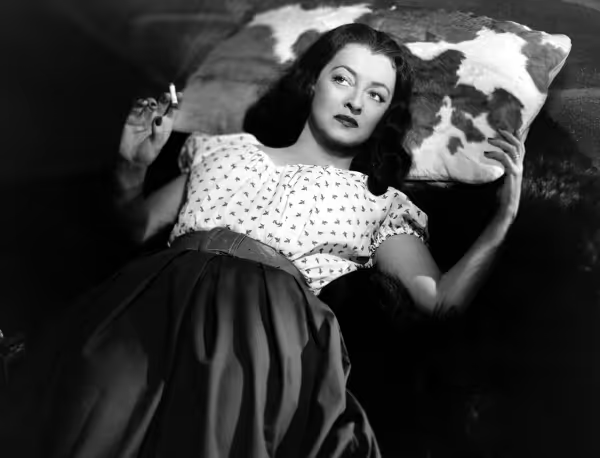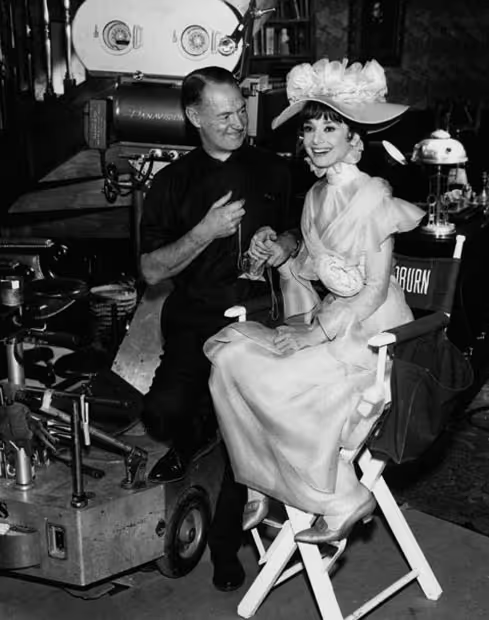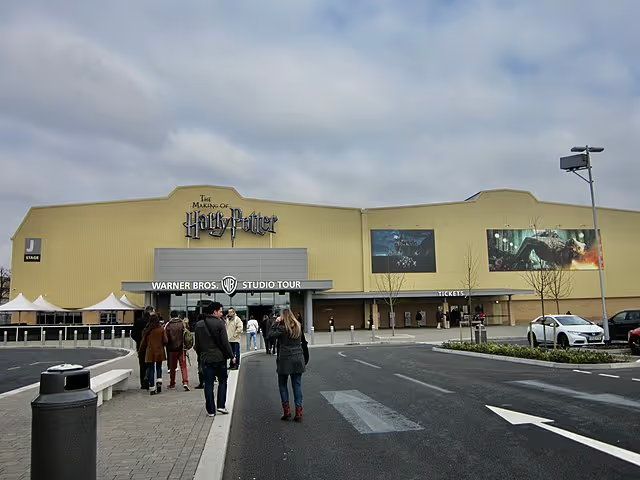From the How you doin’? in Friends to My Preciousss in The Lord of The Rings, Warner Bros. is a name widely known to film and television lovers across the globe.
The journey of Warner Bros. began in 1923, and after numerous name (and business objective) changes, this entertainment company has transformed into 1 of the 5 major American Film Studios.
Having produced 5,000+ TV shows, 7,000+ films, and a whopping total of 75,000+ hours of programs, the company has garnered a huge following, continuing to gross higher and higher with its upcoming movies.
Here are a few statistics that depict the might of the Warner Bros. after a mighty 100+ year tenure:
- Global revenue of 30,44 billion USD in 2020.
- Revenue segmentation of 6,171 billion USD from Television products, 4,389 billion USD from theatrical products, and 1,594 billion USD from games and others in 2020.
- Annual revenue of 132, 993, 000 GBP from Warner Bros. Studio Tour, London.
- Box office market share of 11.7% in the US and Canada in 2020.
- 10,000 employees in the US
Warner Bros. is widely known for its provision of entertainment in the form of films, music, TV shows, and studios.
Headquartered in Burbank, California, but boasting a fan following that goes beyond geographical boundaries, the entertainment company has been making waves in the industry for quite a while.
Let’s travel back to the 1900s and see how the master production house, that gave us classics like The Harry Potter series, came into existence.
The Warner Bros. Inc. Is Born
The story of Warner Bros. begins with the bros – i.e., the 4 Warner brothers (one of whom stars later in the story).
Meet The Brothers
The 3 brothers – Szmuel, Hirsz, and Aaron Wonsal – emigrated to the US from Poland in 1889 with their mother. You must be thinking, Wonsal?!, where’s the Warner in the name.
Well, when the brothers had entered the US, their names were anglicized, as was the norm at the time. Szmuel became Samuel, Hirsz turned into Harry, and Aaron transformed into Albert. While the family name Wonsal became Warner. Therefore, the Warner brothers.
The youngest of the lot, Jack Warner, was born in London, Ontario, and therefore had an American name from the beginning.

Settling in Youngstown, Ohio, Harry opened a shoe repair shop while Sam got a job as a projectionist at Idora Park. Little did they know, this would pave the way for the brothers to enter the entertainment industry – and change it forever!
The First Theatre Opens – And Closes
As Sam ventured into the world of movies in his minor role at the amusement park, he saw potential. Thereafter, he convinced his two brothers – Albert and Harry – to combine their savings and purchase a projector, or rather a Kinetoscope, a primitive form of movie projector created by none other than Thomas Edison.
The projector cost them $1000 at the time, a major investment, but the trio was convinced of the growth potential of this business and took the leap.
Sam and Albert purchased their first copy of The Great Train Robbery and took it to the road, showing flickers of the movie around Ohio and the neighboring state of Pennsylvania.
Their travels stopped when they decided to take their business to the next level – Opening their first theatre.
Called “The Cascade”, the theater opened its doors in New Castle in 1903. The next year, the brothers expanded their business into distribution, founding the “Duquesne Amusement & Supply Company.”

They added another movie house – the Bijou – to their collection in 1905, and by 1909, Jack Warner had also entered the family business. However, as the fee charge of movie distribution became exorbitantly high, the brothers had to sell their business in 1910. Was this the end? No – just the beginning.
This pushed them into taking the reins of the movie-making business, forming their own film production company by 1912, just before the start of the First World War.
The Legend Of Rin Tin Tin
Keeping in mind the current situation and relevant demand in the industry, the brothers purchased rights to their first major film – My Four Years in Germany.
Based on the war in Germany and its aftermath, the film was a success, raking in over $1 million(!), and the profits allowed them to open their first Studio in 1918. The Warner Brothers Studio on Sunset Boulevard, Hollywood, was established.
Merely 5 years later, the revenues were going strong, and the brothers attained a little more financial help from the banker, Motley Flint, to officially incorporate their business.
On April 4th, 1923, the Warner Bros. Pictures. Inc. was born. The oldest, Harry, was President and ran the headquarters of the business in New York City, while Albert operated as its Treasurer. On the other hand, Sam and Jack focused on managing the Hollywood studio.
However, the company did not attract Hollywood glamor until the canine legend, Rin Tin Tin, became a part of its family.
_-_2.avif)
The dog, a male German Shepherd, was rescued during World War I by an American Soldier and was trained for silent film work. When he debuted in Where The North Begins, it was as if the canine took the world by storm.
Immediately impressed by the dog’s star power, Jack Warner signed Rin Tin Tin at a whopping $1,000 / week for more films.
Key Takeaway 1: Go With Your Instincts
The Warner Brothers had a humble background. However, even while pursuing the smallest of jobs, they always trusted their gut feeling and business sense – no matter how high the cost.
As soon as Sam Warner saw potential in the movie distribution business, he convinced his brothers to put up a total of $1,000, a very high amount at the time. When the brothers analyzed the market demand for movie viewing during the World War, they instinctively knew My Four Years in Germany would be a success – and it was.
The same business strategy and instinct were displayed by Jack Warner when he signed Rin Tin Tin immediately after the first success before the dog was picked up by others.
Have faith in and execute your gut feeling, and success was only a few footsteps away, it seemed.
Expanding Horizons
By 1924, the Warner Bros. Studio had become Hollywood’s most successful independent studio, competing with the big leagues – i.e., National, Paramount, and Metro-Goldwyn-Mayer (MGM).
While Rin Tin Tin may have put the Warner brothers on the map, the company was still miles away from achieving the kind of stardom and monopoly on entertainment that it wished to do so.
Make Way For The Talkies
Understanding that their dependence on a single star (i.e., Rin Tin Tin) was not favorable for the business, Sam Warner urged for a drastic change: to license the Vitaphone technology from Western Electric.
Although Harry was initially opposed to the idea, questioning its potential, Warner Bros. finally succumbed to the patent in 1925 after suffering from many financial losses. Little did the brothers know, this was to mark their entrance into a new era of filmmaking.
As a seamless sound transition between the actors and the background made its way to the screen, the company produced the hit it had been waiting for – The Jazz Singer.
Starring Al Johnson, the movie was a phenomenal hit as it ended the era of silent films and brought in the time of the talkies.
Consequently, Warner Bros. came into the limelight, joining the ranks of the top Hollywood studios. They gained over 5 times their investment in revenue, and the Academy of Motion Arts and Sciences also recognized their contribution with a special Academy Award in 1929 for their services in “revolutionizing the industry with sound.”
Unfortunately, the brains behind this strategic move, Sam Warner, passed away from Pneumonia just before the release of the movie in 1927 and therefore could not witness the change his decision had curated for the business now transforming into an empire.
The First Of Many
As their successes continued to pile up, Warner Bros. was able to upgrade from the Poverty Row of Hollywood to create a new, much larger facility in Burbank in 1929. They acquired Stanley Corporation, a chain of theatres, and went on to produce 86+ features in 1929 alone!
They made Lights of New York, the first talking movie of full length, and then went on to produce On With The Show, the first all-talking, color feature film.
The Gold Diggers of Broadway was another unique production that deserves special mention as it played until 1939 and brought about a color revolution!
First the talkies, now the color, it seemed the company was the pioneer of many elements we see used very frequently in the film industry today.
Eventually, by the 1930s, Warner Bros. had expanded film production to about 100 motion pictures annually and was in control of 360 theatres, along with 400+ outside the US. The brothers also built the Warner Theatre in 1931, in loving memory of Sam Warner.
Heading Into Animation
The 1930s were a time when business was booming for the company. However, apart from the usual films. Warner Bros. also marked its entry into the world of cartoons.
It allocated a small administration building to the Animation Department, headed by Ted Avery at the time. Consequently, in 1931, the efforts of the production team bore fruit as the first Looney Tunes (yes, tunes not toons) cartoon was released. Called Sinkin’ in the Bathtub and starring Bosko, the cartoon was an immediate success. A sister series, Merry Melodies, was also created.
The cartoons gained acclaim from far and wide with their fast-paced, cheeky style and sarcastic sense of humor. In 1936, however, it seemed that Warner Bros. had finally found its cartoon star in Porky Pig – the animated series that continues to trend today.
Daffy Duck and Bugs Bunny debuted soon after and helped the expansion of Warner Bros.’ existing consumer base. From movies that mostly appealed to adults, the entertainment company had ventured into the target market of children and made an impact.
It comes as no surprise then that by the 1940s, the cartoons of Warner Bros. had surpassed those produced by the Walt Disney Studios, terming Warner Bros as perhaps the most successful producer of animated short films in America.
Warner Bros: The Gangster Studio
As the animation unit was set up, something truly different was in the works for Warner Bros. alongside it.
From the Jazz Singer to many other films later, the company had been producing many musicals. So much so that people began to associate the idea of color films with musicals – a connotation that the business did not want to prosper.
Therefore, as demand for musicals declined, Warner Bros. searched for another market trend to catch up on. After conducting thorough market research and analyzing trends, they realized the viewers wished for realistic storylines, different from the usual musicals and comedies. So, the company turned to producing gangster films.
Beginning with Little Caesar, the company released a myriad of related films like Public Enemy, I Am A Fugitive From A Chain Gang, Scarface, etc., that garnered huge success. In fact, the antagonist from the Public Enemy, James Cagney went on to become Hollywood’s most notorious gangsters, and therefore a feather in the cap for the Warner Bros.
In addition, the 1930s also became a good time for the company as the president, Franklin D. Roosevelt, announced the New Deal, which allowed the company to become profitable again while also raising employee salaries.
Warner Bros. was also able to build nine new soundstages, of which stage 16 gained completion in 1935 and became the tallest soundstage in the world. The same stage later went on to be utilized in classics like Jurassic Park.
If Warner Bros. needed anything else to churn in revenue and enhance market share – this was it.
Key Takeaway 2: Expansion Is Key
By the 1920s, Warner Bros.’ industrial success was on an upward trajectory. However, dependence on a few stars to run the show was not conducive to good business, and the brothers realized this.
Therefore, adopting strategies of innovation, they expanded to unventured markets and became the pioneer of many trends in the industry, such as Talkies and Color Films. This gave them a competitive edge over others.
In addition, venturing into highly diverse areas like Animation and Gangster films also meant that Warner Bros. had divided its eggs into multiple baskets, appealing to wider market segments and expanding its consumer base, holistically.
The Company Is Shook
The 1930s were a profitable time for Warner Bros., courtesy of the diversification into animation and gangster films. However, as the Motion Picture Production Code (also known as the Hays Code) was enforced, the company had to switch towards the production of more moralistic movies with lesser violence and profanity.
Venturing Into Historical Dramas
The company dropped the idea of gangster films and pushed its investment into producing historical films like The Petrified Forest and melodramas like Dark Victory.
This brought another star into the limelight – Bette Davis. She performed a whopping 38 film roles (yes, that’s right!) during her tenure of 8 years, from 1932 until 1940.

Her popularity brought the studio so much fame that she was also occasionally called the “Fifth Warner Brother.” Surprisingly, Davis was unhappy with her roles and even tried to break the contract. However, she lost the lawsuit and had to complete her tenure. It was at this time that another crucial aspect came into the light; many actors were unhappy with Jack Warner, as was the case with Davis, while they considered Albert and Harry Warner to be fair.
In 1940, Davis left, and this was the beginning of trouble for Warner Bros. – the first in many years.
The Brothers Break
In the last few decades, the company had enlarged by numerous departments and acquisitions. In the 1940s, however, an anti-trust case was filed against these 5 studio-theater chain combinations that had begun to monopolize the entertainment industry.
Called the United States v. Paramount Pictures, Inc. case, Warner was also party to it, and when the decision ruled in favor of the government in 1948, Warner Bros. had to separate its production from the others.
A year later, its profits were down to merely $10 million.
Trying to make a comeback, the next few years included some less-than-beneficial decisions by Jack Warner. The company was forced to expand into 3D films production to counter the threat of television and almost went bankrupt doing so.
%2520(1).avif)
The profits were down to $2-4 million in 1956, and the brothers decided it was time to sell. However, Jack secretly formed a syndicate and bought 90% of the stock of Warner Bros. As soon as his brothers retired, he was now the largest stockholder, and therefore appointed himself as the president of Warner Bros.
The bros in the Warner Bros. had broken. Harry passed away in 1958, and Jack did not even attend his funeral. Albert, likewise, left the world in 1967 and had never spoken to his brother after the syndicate.
Looking Ahead
Understanding the demand for television series that continued to rise, Jack decided to enter the market too, instead of trying to find alternatives to withstand the competition.
The Warner Bros. Television Unit was formed in 1955, and its reins were handed over to Jack’s son-in-law, William. It seemed like Jack may have broken away from his initial family, his was to keep the Warner Bros. in the current family for the future.
From the western series Cheyenne to Maverick and 77 Sunset Strip, the success of these formats helped the company make up for the losses they had endured in the past. Consequently, in the years 1961-63, the company made a little over $7 million in profits, a major improvement.
It was then that Warner Bros. decided to visit the past, i.e., musicals, to push their growth. Purchasing the rights to My Fair Lady, a Broadway musical, the company was able to transition from the “Golden Age of Hollywood” to “New Hollywood” while creating a subsidiary in the journey – Warner Bros. Records.

Key Takeaway 3: Trust Your Business Skills
From the Hays Code to its aftermath, most of the innovations did not seem to work in favor of the company. 3D films weren’t churning enough in revenue, and iconic stars continued to terminate their contracts with Warner Bros.
However, in the face of adversity and losses, Jack Warner trusted his business skills and knew the business had the potential to transform into a global empire. Therefore, instead of selling, he strategized a way to keep the company within the family. Soon enough, after a few years of enduring losses, the timely decisions of the president led the company to its successful track yet again, delivering hits like Maverick that continue to be the favorite of millions today.
The Fall And Rise Again
As time progressed and the movie production soared, Jack Warner realized his advancing age meant he could not remain in control of the decision-making forever.
Warner Bros. Is Sold
This was when he made the strategic move of selling the studio and music label to Seven Arts Productions in November 1966, for $32 million.
Seven Arts was run by Elliot and Kenneth Hyman, who, after the sale, renamed the company Warner Bros. – Seven Arts.

However, not giving up the control just yet, Warner remained in the position of the President, and one year later, moved to the designation of Vice President and an independent producer. This was also the year when the company came up with its newest star – Bonnie and Clyde.
Unfortunately, by 1969, Seven Arts had developed differences with Jack Warner and knew the alliance could no longer continue. Therefore, when the Kinney National Company (a conglomerate) made a cash-and-stock offer of $64 million, the studio jumped at the opportunity and made the sale.
The name of the company was changed to “Warner Bros. Inc.”. While Jack Warner, outraged by the sale, moved into independent production and eventually retired in 1973, and passed away in ’78.
The Warner brothers had gone, but the company was flourishing.
The Warner Bros. Rises Again
The Kinney Corporation was headed by Steven J. Ross, who believed in leveraging star power to make strides in the industry. Legendary actors like Clint Eastwood, Barbra Streisand, and Paul Newman were signed, and the next two decades were years of unique, blockbuster hits.
While big-screen movies such as The Exorcist (remember the stairs scene?) and Blazing Saddles remained on the forefront, the company also entered the market of comics.
A new subsidiary called DC Comics was created that gave us the popular characters of Batman, Superman, and Wonder Woman.
In another strategic move, the company partnered with 20th Century Fox in 1973 to co-produce The Towering Inferno, which went on to become the 2nd highest-grossing film of 1974. The inflow of mighty high profits was the signal the company needed to shift their objective from being a conglomerate to focusing on their best holding – Warner Communications. Consequently, Kinney National Company moved out of the parking lot and funeral home business.
The Merger That Changed It All
By the late ‘80s, the company was doing well. Expansions and diversification meant it had captured a huge market and the revenues continued to churn despite trend changes. In 1989, the company also entered the Cable Television industry with its acquisition of Lorimar Telepictures.
However, the real merger came a year later, in 1990. Warner Communications merged with the most elite in the industry, Time Inc. Together, they formed the world’s largest communication and entertainment company – Time Warner Inc.

It seemed that after this, success came trickling down for the company. The Warner Bros. Studio Store was created in 1991 with special merchandise by the entertainment company. From the Looney Tunes mascots to Superman figurines, everything was available.
Warner Bros. Family Entertainment was established in 1992, while the company also purchased the famous amusement park, Six Flags, in 1993 (which was to be sold later).
The WB Television Network was launched in 1995, especially targeted at the teenager niche interested in watching movies on the telly. What came next were cult classic shows like Buffy the Vampire Slayer, One Tree Hill, and even Charmed – which lasted 8 seasons to become the longest-running TV series with a female protagonist.
In 1996, they bought Turner Pictures for a $7.5 billion stock deal, gaining access to TV channels like CNN, Cartoon Network, TBS, and TNT.
Key Takeaway 4: Don’t Be Afraid To Make Unconventional Choices
Diversification is key for a business’ growth. However, making the right decisions to expand at the right time is crucial – and so it was shown by Warner Bros.
Whether it was the decision to sell to Kinney National Company, merge with Time Inc., or expand into unprecedented businesses like stores, amusement parks, comics, and TV channels, the company, and its management made unconventional yet calculated choices to rise again from their stumble and become the best in the industry.
The Warner Bros. Of The 2000s and Today
While the Time Warner merger was monumental in making the business what it is today, the company did continue to face a few ups and downs before gaining the position it currently holds.
A Takeover That Didn’t Work
In 2000, the then high-flying company AOL took over Time Warner Inc. to form the worst-ever merger in American history.
Following the dot-com popularity, AOL had gained immense popularity and therefore inflated stocks. This led the company to acquire Time Warner in a whopping $183 billion merger. However, as the dot-com bubble burst and the stocks came tumbling down, just a year later the company was declaring a loss of $99 billion.
With the deteriorating goodwill of AOL, Time Warner distanced itself from AOL, banishing it from its corporate name. Eventually, the internet company became uninvolved with the entertainment company by 2009 and was bought later by Verizon for merely $4.4 billion – a much lower amount than the merger.
Rise To The Sky
In the late 1990s, the company had attained license of the Harry Potter movies, and by the 2000s, the release had begun. Thereafter, it seemed that the fall that the company had endured due to the unsuccessful merger had been nullified by the sensational popularity of the Harry Potter series.

The company joined with the China Film Group Corporation, producing movies in Hong Kong and China. By 2008, they had brought about the Blu-Ray Disc revolution, discontinuing the HD DVD format.
With continuing successes, the company added another to the list with The Dark Knight Rises and the first of the Lord of the Rings’ prequel movies – The Hobbit: An Unexpected Journey. These were some of the few films in the world that managed to cross the $1 billion mark in 2015.
Joining With AT&T
In 2018, the Time Warner company underwent another major change. It was acquired by a US Telecom company, AT&T, for $85 billion and renamed WarnerMedia – the same name it carries today.
The logo of the company was changed to define the new, modern, WarnerMedia with a distinct typeface, and a streamlined appearance that makes it conducive to usage in multiple platforms and streaming devices.
The logo debuted with Christopher Nolan’s Tenet in 2020, and a refined version was then released with Locked Down in 2021 on HBO max. An application was also created for the channel, allowing for improved, convenient viewing.
Warner Media Today and Tomorrow
While Warner Media continues to enjoy its high position in the entertainment industry, the management understands that the hustle must never stop.
Therefore, in May 2021, AT&T conducted talks with Discovery Inc. and decided upon a merger between Discovery Inc. and Warner Media to create a standalone, public company called Warner Bros. Discovery. The enterprise would be owned 79% by AT&T and 29% by Discovery Inc. – ushering in new possibilities and horizons for this entertainment behemoth to conquer!
Key Takeaway 5: Have A Growth Mindset
A merger with the best in the industry – Time Inc. – might have put Warner Bros. on the map again, but the innovation had to continue if the company was to make profits in the future.
This meant making decisions according to the growth mindset. While some went wrong, such as the AOL takeover, others like joining with AT&T, changing the logo, creating new movie series, and modernizing their infrastructure helped them surpass their failures and make strides towards business success.
Summary and Strategic Takeaways
Warner Bros. is not a mere entertainment company. It is a legacy that has changed the lives of countless children and adults and defined their memories.
Delivering unforgettable hits like Casablanca and Wonder Woman, to the Looney Tunes and beyond, the company has led the world of entertainment to unsurmountable heights.
As a division of the Time Warner company and owning more than 50% of the shares of CW Television Network, Warner Bros. have thousands of feature films, television series, and animated titles under their belt – and the tally continues to climb.
Growth By Numbers
Strategic Takeaways
From a company that started with one projector to one that is globally recognized as one of the leading media firms in the world, there is much to learn from the incredible journey of Warner Bros.
Let us recount some of the key strategies the company followed to reach its position today:
- Believe In The Objective
A business can seldom succeed if its owners do not believe in it. This was true in the case of Warner Bros.
From setting foot in his minor role in the amusement park, movie-viewing vicinity, Sam Warner realized the potential of the entertainment industry and stuck to it. He believed in the objective and therefore encouraged his brothers to make a hefty investment in a projector. Similarly, upon touring Pennsylvania, he believed this was the place to lay their roots and so they did so, with their first theatre Cascade.
The youngest Warner brother, Jack, especially played a crucial role in the firm’s success as his determination and belief to lead the firm beyond obstacles and losses with strategic decision making helped the company stay in the family until almost his death.
- Diversification Is Essential
Perhaps one of the leading causes of Warner Bros.’ success was their diverse product portfolio.
While it began with movie viewing and distribution, the company soon expanded into other niches such as animation, video games, musicals, color movies, blue-ray discs, merchandise stores, amusement parks, and more.
By dividing its investment into multiple segments, the company was able to stay afloat even if one segment wasn’t doing well (such as the sale of Six Flags in 1998).
- Do Not Shy Away From Difficulty
A business cycle consists of 4 stages – the expansion, boom, recession, and slump.
Just as Warner Bros. had seen their expansion and boom, there came times when the company was barely making any profits.
Whether it was the breaking of the brothers and the almost sale of the company into non-family members, the sale to Seven Arts, or the (worst) merger with AOL, the company went through crucial periods.
However, the management of these times helped the company through the survival tenure by making difficult but necessary decisions such as the secret syndicate by Jack Warner, sale to Kinney National Company by Seven Arts, and separation from AOL later in the 2000s.
- Take The First Step
Sometimes the business is required to make unprecedented, unforeseen decisions. However, they must be taken for the enterprise’s stability and longevity.
In the case of Warner Bros., the company was the first in many: the first to create a color movie, introduce sound in film, switch to blue-ray discs, co-produce with other production houses, etc.
It was Warner Bros.’ unwavering persistence and business prowess that helped them progress ahead through modernization, pioneering, and improvements.
- Keep Innovating Come What May
Change is inevitable, and the businesses that adapt to change are the ones that manage to succeed through the struggles of time – and Warner Bros. is proof.
The company never stopped innovating at any stage. Deviating far from a fixed mindset, each management came with new, fresh ideas. From converting famous books into movies such as the Harry Potter and the Lord of the Rings series to revamping the logo for a modern perspective, the company has always been at the creative forefront.
Its current strategy to partner with Discovery Inc. to create a new company is also a sign of their innovative decision-making as the merger will not only be another feather in the cap of the Warner Bros. empire but also usher in a new age of possibilities with an educational partner like Discovery.
The Warner name has grown to become an empire, leading a revolution in entertainment and tracing back to the little city of Youngstown, where the lives of the Warner brothers continue to inspire culture and traditions.



